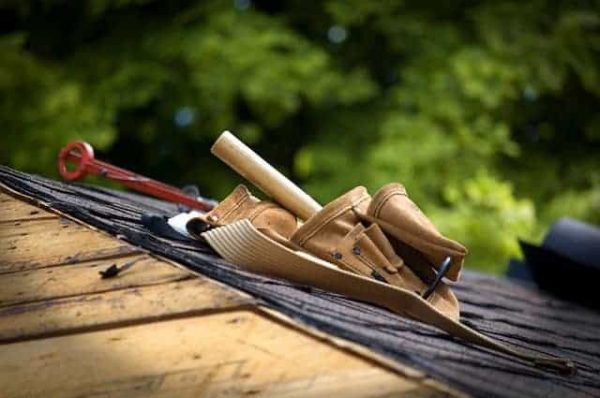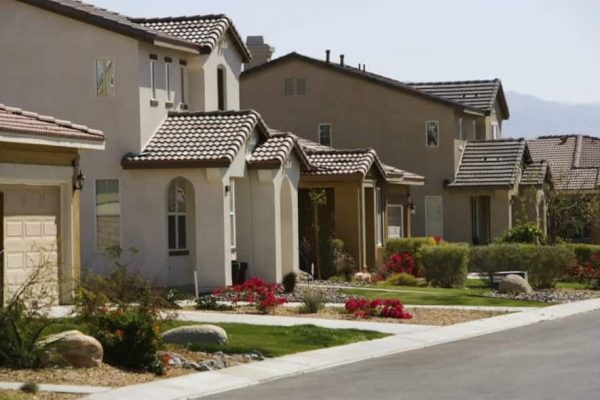
Whether you’re a homeowner or a professional contractor, understanding the term roofing square is essential in the roofing industry.
A roofing square is a unit of measurement used in the roofing industry, representing 100 square feet. This standard measurement simplifies the process of estimating material needs and costs.
We aim to provide an in-depth understanding of roofing squares. You’ll learn how to calculate them accurately, consider the impact of different materials on pricing per square, and explore essential factors to consider when estimating roofing costs.
If you’re looking for a roof repair estimate, contact Divided Sky Roofing & Solar for a fast and fair assessment. We offer expert residential roofing services and can get you a fair and accurate quote for roof repair and replacement, quickly.
Understanding Roofing Squares
A roofing square is a vital unit of measurement in the roofing industry. It represents an area of 100 square feet. To visualize this, imagine a 10-foot by 10-foot section of your roof. This straightforward measurement helps both homeowners and contractors communicate effectively about the size of a roofing project.
Why Use Roofing Squares?
Roofing squares simplify the process of estimating material needs and costs. By breaking down the roof into manageable sections, contractors can:
- Quickly calculate how many shingles or other materials are required.
- Accurately assess labor requirements and timeframes.
- Provide precise estimates for project pricing.
Visual Representation
Consider this example: If your roof’s total area is 2,500 square feet, you would divide that by 100 to find that you need 25 roofing squares. This modular approach allows for more efficient planning and execution.
Application in Estimations
Using roofing squares ensures consistency across different projects and materials. Whether you’re dealing with asphalt shingles, metal panels, or flat roofing systems, knowing the number of squares helps standardize calculations. For instance:
Shingle Roof Cost per Square Foot: Knowing your roof’s size in squares allows you to estimate costs more accurately since shingle prices are often quoted per square foot.
Understanding roofing squares is fundamental for effective communication and planning in any roofing project. This knowledge empowers homeowners to make informed decisions and enables contractors to deliver precise estimates and high-quality work.
Calculating Roofing Squares Accurately
Estimating roof square footage is a crucial step in determining how many roofing squares you’ll need for your project. Here’s a simple guide to help you calculate it accurately:
- Measure the Length and Width
- Use a tape measure to find the length and width of each section of your roof.
- Write down these measurements for reference.
- Calculate the Area
- Multiply the length by the width to get the area in square feet for each section.
- Sum Up Total Square Footage
- Add up the areas of all sections to get the total square footage. If your roof has multiple sections, ensure you account for each one.
- Divide by 100
- Since one roofing square equals 100 square feet, divide your total square footage by 100.
Considerations such as roof shape and pitch significantly affect material requirements. A steep-pitched or complex-shaped roof like a gambrel or mansard will require more materials due to additional surface area and potential waste during installation.
Accurate measurement is vital to avoid underestimating or overestimating your needs, ensuring a smooth and cost-effective roofing project.
Factors Influencing Roofing Costs per Square
The shape of your roof significantly impacts material needs and the waste factor during installation. Different designs like gambrel, mansard, and gable roofs each have unique characteristics that affect the cost.
Roof Designs and Their Impact on Costs
- Gambrel Roofs: Known for their barn-like appearance, gambrel roofs require more precise cutting of materials, resulting in higher shingle waste.
- Mansard Roofs: These roofs feature a steep slope on all four sides. The complexity of this design often leads to increased labor and material costs.
- Gable Roofs: With their simple triangular shape, gable roofs are generally easier to work with, leading to less material waste.
Common Roofing Materials
When it comes to roofing materials, options like asphalt shingles and metal roofs dominate the market. Each has its own set of requirements and costs:
- Asphalt Shingles: Typically sold in bundles covering about 33 square feet each.
- Shingle Waste: Due to cutting and fitting around roof features, expect an additional 10% waste.
- Metal Roofs: Usually sold by the panel or in rolls for specific dimensions.
- Waste Factor: Similar to asphalt shingles but can be slightly less due to fewer cuts required.
Understanding these factors helps in making informed decisions when planning your roofing project.
Pricing Breakdown per Square Foot
Understanding the costs associated with different roofing materials is essential for effective budgeting. Here’s a comparative analysis based on current market trends:
Asphalt Shingles
- Price per Square Foot: Typically ranges from $3 to $5.
- Pros: Affordable, widely available, and easy to install.
- Cons: Shorter lifespan compared to metal or flat roofs.
Metal Roofs
- Price per Square Foot: Averages between $7 to $20.
- Pros: Durable, energy-efficient, and low maintenance.
- Cons: Higher initial cost, requires professional installation.
Flat Roofs
- Modified Bitumen/TPO Cost per Square Foot: Generally falls between $4 to $9.
- Pros: Excellent for modern aesthetics and easy maintenance of HVAC systems placed on the roof.
- Cons: Potential for water pooling, may require more frequent inspections.
These prices are influenced by factors such as material quality, labor rates in your area, and specific project requirements. For those in Central Texas looking for precise estimates tailored to their needs, Divided Sky Roofing & Solar offers competitive pricing and exceptional service.
Understanding Labor Costs in Roofing Projects
Labor costs for roofing projects can vary widely, influenced by several key factors. Understanding these variables helps homeowners budget effectively and choose the right contractor for their needs.
Factors Influencing Labor Rates
Contractor Experience: Experienced contractors often charge higher rates due to their expertise and reliability. For example, a seasoned roofer might charge more per hour compared to a novice, but the quality and speed of work generally justify the cost.
Project Complexity: Simple roof repairs versus complete replacements come with different labor requirements. Complex designs such as mansard or gambrel roofs may require more time and specialized skills, increasing labor costs.
Average Cost Insights
The average cost to replace roof shingles can range from $3 to $7 per square foot, up to $20+ per sq. foot. This includes labor and materials but can fluctuate based on local market conditions and specific project details.
For metal roofs, labor costs might be higher due to the intricate installation process required for materials like standing seam panels.
Hiring reputable contractors, such as GAF-certified professionals, ensures that you receive accurate estimates and high-quality workmanship.
Getting Accurate Estimates for Your Roof Repair Needs
Obtaining precise estimates is essential for effective budgeting and avoiding unexpected costs. Knowing how to estimate roofing costs accurately helps you plan your project and ensures you get the best value for your investment.
Here are some tips to find reputable contractors who can provide reliable assessments:
- Look for Certifications: Seek out GAF-certified professionals. These experts have undergone rigorous training and are recognized for their quality workmanship.
- Check Reviews and References: Online reviews and references from past clients can give insights into a contractor’s reliability and service quality.
- Request Multiple Quotes: Obtaining several quotes allows you to compare prices and services, ensuring you make an informed decision.
- Verify Insurance and Licensing: Ensure the contractor is properly insured and licensed to work in your area, which protects you from liabilities.
Accurate estimates help in setting realistic budgets, making informed decisions, and ensuring a smooth roofing project from start to finish.
Get an Accurate & Competitive Estimate Today
Understanding roofing squares is crucial for both homeowners and contractors to ensure accurate material estimation and cost management. This knowledge can prevent costly mistakes and help with budgeting effectively.
For any roofing concerns or to get a precise estimate, contact Divided Sky Roofing. Our team provides quick and reliable assistance, ensuring your roofing needs are met with the highest quality service.
FAQs about Roofing Square
How do features like skylights and chimneys affect the calculation of roofing squares?
Features like skylights and chimneys require precise cutouts, which means subtracting their area from the total. However, it’s important to account for extra material needed around these features for proper installation.
Is there a difference in measuring roofing squares for shingle versus metal roofs?
Measuring the roof surface area is the same for both materials, but installation considerations and material coverage may vary, resulting in slight adjustments when ordering supplies.
What’s the typical waste percentage I should add to the total number of roofing squares?
Generally, add 10-15% for waste on a simple roof and 15-20% for more complex roofs to the total number of roofing squares to ensure enough material is on hand.
How does the type of roofing material affect the number of squares I will need?
Different roofing materials come in various sizes and coverage capacities. For instance, some heavyweight or dimensional shingles may cover less area per bundle than standard three-tab shingles, potentially changing the number of squares needed.
Can the weather and climate in my region impact the number of roofing squares required for my project?
Climate doesn’t directly affect the number of squares but can influence material choice and installation processes. It’s critical to choose materials suited for your region’s weather, which may come in different sizes or quantities.
When should I consider getting my roof replaced, and how do factors like storms, hail, and age contribute to the decision?
Consider roof replacement when you notice signs of significant wear and tear or after severe weather events. Factors prompting replacement include:
- Age of Roof: If your roof is nearing the end of its expected lifespan (20-30 years for asphalt shingles, 50+ years for metal or tile), it may be time to replace it before problems arise.
- Storm and Hail Damage: High winds can lift or break shingles, and hail can cause dents or cracks, compromising your roof’s integrity. After such events, a professional inspection can determine if repairs will suffice or if a replacement is warranted.
- Extensive Leaking: Multiple leaks or a single severe leak can signal that your roofing system is failing and may necessitate a complete replacement to prevent structural damage to your home.
- Widespread Damage: Issues like widespread shingle granule loss or large areas of buckling and curling shingles often indicate that your roof’s condition is deteriorating and may not protect your home effectively.
- Energy Inefficiency: An old or damaged roof can lead to higher energy bills due to poor insulation. Upgrading to a new, more efficient roofing system could reduce your energy costs.
from: https://mydividedsky.com/what-is-a-roofing-square-your-ultimate-guide-to-roof-measurement/


No comments:
Post a Comment